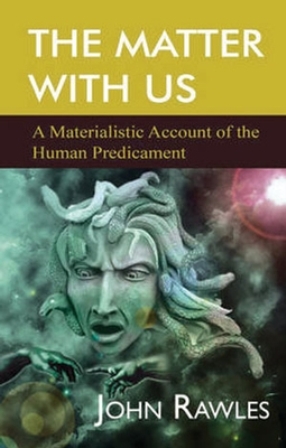Review by
James Zimmerman
The Matter With Us
by John Rawles, ©2011
Pen Press, 516 pages
 Rawles’ cleverly titled book begins most ominously. In comparing our planet to a space craft, a stark page appearing event before the table of contents details our predicament: “The bridge of spaceship Earth is deserted,” it begins, “nobody is in charge.” Mentioning the fighting, looting, and squandering, Rawles coldly admits that though most passengers on the ‘spaceship’ wish to enjoy “the cruise of a lifetime in safety, comfort and good health,” such a prospect seems unlikely. Almost as a sarcastic afterthought, Rawles adds, “And it was such a beautiful ship.”
Rawles’ cleverly titled book begins most ominously. In comparing our planet to a space craft, a stark page appearing event before the table of contents details our predicament: “The bridge of spaceship Earth is deserted,” it begins, “nobody is in charge.” Mentioning the fighting, looting, and squandering, Rawles coldly admits that though most passengers on the ‘spaceship’ wish to enjoy “the cruise of a lifetime in safety, comfort and good health,” such a prospect seems unlikely. Almost as a sarcastic afterthought, Rawles adds, “And it was such a beautiful ship.”
Witty metaphors aside, Rawles sums up the current state and future prospects of humanity into what he terms as “Nine Gordian Knots” (page 432). Any one of these ‘knots,’ he contends, could unravel the current precarious state of the world and even the future prospects for humans and other species. Among the grave problems at humanity’s doorstep are the end of oil, climate change, environmental degradation, and armed conflict. Regarding this final problem, Rawles spends several pages dishing out copious amounts of shocking and unsettling facts that lead to the conclusion that “all five permanent members of the UN Security Council have a vested interest in perpetual, global, armed conflict” (464). The other eight ‘knots’ offer similarly upsetting eventualities.
.Nevertheless, Rawles has no intention of leaving his readers feeling powerless and hopeless; he even titles this final chapter “Epilogue - or New Chapter?” in the hopes that the situations can be remedied. For each problem he offers practical, attainable, “quixotic things to do to counter” the impending catastrophe (481). Some of the suggestions involve donating time or money, others include voting or supporting certain benevolent organizations.
And indeed, this final, sprawling chapter (it’s over 60 pages!) is only that: one chapter in a long, detailed book. Starting at the beginning, the first nine chapters go into great detail explaining how it is we have come to this point in our history. And I do mean the beginning; Rawles begins his book at the moment of the Big Bang. After providing an overview of that first moment in time, Rawles answers the obvious question: How do we know about the Big Bang? This then leads to a sidetracking subheading explaining the use of metaphor in talking about abstract concepts, such as mathematics and gravity. Rawles also sprinkles his book with several ‘boxes’ that explain tougher concepts, such as chaos, relativity, and the four basic forms of human relationships. These boxes are somewhat of a distraction from the main text, but as they are clearly set off by headers and borders, readers can choose to read them as they come, or save them for later (or not read them at all).
The book next explores the evolution of life from matter, and the evolution of the human mind from matter. The evolution of morality, religion, and capitalism also receive a chapter each. Rawles offers plausible, definitive reasons for religion’s development and also shows how humans need to progress past religion if they are to triumph over their difficulties.
Rawles also shows how seemingly insignificant events in history have brought us to today. Most notably, he argues that the import of cheap cotton from India gave the West the industrial revolution (280). And to demonstrate that our minds – spectacular as they may be – are still nothing more than faulty matter, Rawles uses examples from Tony Blair’s administration to illustrate one human’s predilection for reification, over-reliance on intuition, and belief without evidence (341-8). In each case, Blair was acting as an imperfect, evolved mass of matter can be expected to act and react.
Rawles contends that the nine ‘knots’ are interconnected, and a chart inside the front cover vividly depicts the threads that tie each knot to the others. Looking at the chart right away is a bit bewildering, but referring to it as the book proceeds will give readers satisfaction as they take in the interpretation Rawles offers for the whole of civilization.
Each chapter is copiously annotated (there are often over 100 endnotes for a single chapter), highly readable even for those not disposed to social or physical sciences, and indexed for future reference. Rawles’ tome is a diagnostic tour de force of the human predicament. It answers: How did we get here? How will it end? And, as the back cover asks: are we pawns or players? I strongly recommend this book for all atheists who wish to have a better understanding of the matter.

